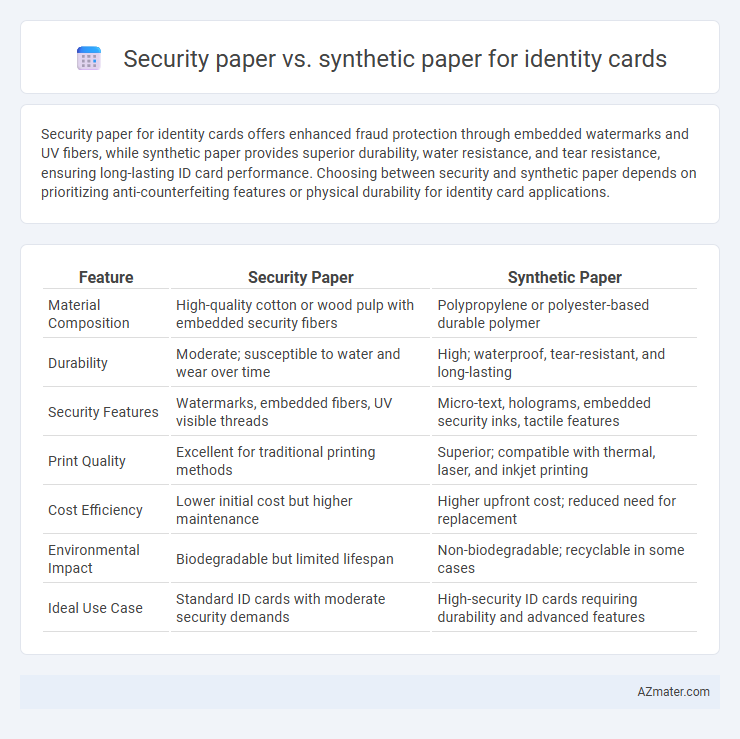Security paper for identity cards offers enhanced fraud protection through embedded watermarks and UV fibers, while synthetic paper provides superior durability, water resistance, and tear resistance, ensuring long-lasting ID card performance. Choosing between security and synthetic paper depends on prioritizing anti-counterfeiting features or physical durability for identity card applications.
Table of Comparison
| Feature | Security Paper | Synthetic Paper |
|---|---|---|
| Material Composition | High-quality cotton or wood pulp with embedded security fibers | Polypropylene or polyester-based durable polymer |
| Durability | Moderate; susceptible to water and wear over time | High; waterproof, tear-resistant, and long-lasting |
| Security Features | Watermarks, embedded fibers, UV visible threads | Micro-text, holograms, embedded security inks, tactile features |
| Print Quality | Excellent for traditional printing methods | Superior; compatible with thermal, laser, and inkjet printing |
| Cost Efficiency | Lower initial cost but higher maintenance | Higher upfront cost; reduced need for replacement |
| Environmental Impact | Biodegradable but limited lifespan | Non-biodegradable; recyclable in some cases |
| Ideal Use Case | Standard ID cards with moderate security demands | High-security ID cards requiring durability and advanced features |
Introduction to Security Paper and Synthetic Paper
Security paper is specifically engineered with embedded features such as watermarks, UV fibers, and microtext to prevent counterfeiting and unauthorized duplication of identity cards. Synthetic paper, composed of durable plastic resins like polypropylene, offers enhanced resistance to water, tearing, and chemicals, making it ideal for long-lasting identity cards in harsh environments. Both papers serve critical roles in secure identity documentation but differ fundamentally in composition and security feature integration.
Key Features of Security Paper for Identity Cards
Security paper for identity cards incorporates advanced anti-counterfeiting features such as watermarks, embedded fibers, and holographic elements that enhance document authentication and prevent forgery. These papers offer durability and tamper-evidence, ensuring the card's integrity throughout its lifecycle under varying environmental conditions. Unlike synthetic paper, security paper maintains high resistance to chemical alterations and physical manipulation, making it the preferred choice for high-security identification documents.
Distinctive Properties of Synthetic Paper
Synthetic paper for identity cards offers superior tear resistance, water resistance, and durability compared to traditional security paper, ensuring long-lasting credentials even under harsh conditions. Its smooth, non-porous surface enables high-quality printing and resistance to fading, crucial for maintaining clear, tamper-evident security features. Unlike security paper, synthetic paper also resists chemicals and abrasion, enhancing protection against counterfeit and unauthorized alterations.
Durability: Security vs Synthetic Paper
Security paper offers moderate durability with built-in anti-counterfeit features like watermarks and security fibers, but it can be susceptible to wear and tear over time. Synthetic paper surpasses traditional security paper in durability due to its waterproof, tear-resistant, and chemical-resistant properties, ensuring long-lasting identity cards under frequent use. Combining durability with advanced security elements makes synthetic paper an ideal choice for robust and secure identity card production.
Security Features and Counterfeit Resistance
Security paper for identity cards incorporates advanced embedded features such as microtext, UV-reactive elements, and holograms, enhancing counterfeit resistance through direct integration into the substrate. Synthetic paper offers durability and water resistance but often lacks the inherent security attributes of specialized security papers, requiring additional lamination or overlay security measures to prevent forgery. The choice between security paper and synthetic paper hinges on the balance between intrinsic anti-counterfeit properties and physical robustness needed for identity card longevity.
Cost Comparison: Security Paper vs Synthetic Paper
Security paper for identity cards generally incurs higher costs due to embedded anti-counterfeiting features such as watermarks, holograms, and microtext, which require specialized manufacturing processes. Synthetic paper, made from durable plastic materials like polypropylene, offers competitive pricing by reducing maintenance and replacement expenses associated with wear and tear, despite a higher initial investment. Cost efficiency depends largely on the specific application requirements, with security paper favored for high-security needs and synthetic paper preferred for longevity and ease of production.
Environmental Impact and Sustainability
Security paper for identity cards often contains embedded fibers, watermarks, and chemical treatments that complicate recycling processes and increase environmental waste. Synthetic paper, made from plastic resins like polypropylene, offers enhanced durability and resistance to moisture, reducing replacement frequency and resource consumption over time. Despite its plastic base, synthetic paper can be more sustainable due to its longevity and potential for recyclability in specialized facilities, lowering overall environmental impact compared to traditional security paper.
Printing and Personalization Capabilities
Security paper offers advanced anti-counterfeiting features such as watermarks, microtext, and UV fibers, enhancing document authenticity in identity card printing. Synthetic paper provides superior durability, water resistance, and tear-proof characteristics, enabling high-quality printing with thermal transfer or direct-to-card technologies. Personalization on synthetic paper supports variable data printing and embedded security elements like holograms, making it ideal for secure identity card applications requiring long-term usage.
Real-World Applications and Case Studies
Security paper for identity cards offers enhanced anti-counterfeiting features such as watermarks, microtext, and embedded holograms, widely adopted by government agencies to prevent forgery in passports and driver's licenses. Synthetic paper, made from durable polymers, provides superior resistance to water, chemicals, and tearing, making it ideal for long-term use in employee badges and access control cards in industrial environments. Case studies from border control and corporate security sectors demonstrate that combining security paper's tamper-evident properties with synthetic paper's durability significantly improves identity card longevity and fraud prevention.
Choosing the Best Material for Identity Cards
Security paper offers enhanced anti-counterfeiting features such as watermarks, embedded fibers, and holograms, making it ideal for high-security identity cards requiring stringent verification. Synthetic paper provides superior durability, resistance to water, chemicals, and tearing, ensuring long-lasting identity cards suitable for frequent handling in various environments. Selecting the best material depends on balancing the need for security features with durability requirements to ensure identity cards effectively prevent fraud while enduring everyday use.

Infographic: Security paper vs Synthetic paper for Identity card
 azmater.com
azmater.com